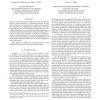Free Online Productivity Tools
i2Speak
i2Symbol
i2OCR
iTex2Img
iWeb2Print
iWeb2Shot
i2Type
iPdf2Split
iPdf2Merge
i2Bopomofo
i2Arabic
i2Style
i2Image
i2PDF
iLatex2Rtf
Sci2ools
ICASSP
2010
IEEE
2010
IEEE
Toward signal processing theory for graphs and non-Euclidean data
Graphs are canonical examples of high-dimensional non-Euclidean data sets, and are emerging as a common data structure in many fields. While there are many algorithms to analyze such data, a signal processing theory for evaluating these techniques akin to detection and estimation in the classical Euclidean setting remains to be developed. In this paper we show the conceptual advantages gained by formulating graph analysis problems in a signal processing framework by way of a practical example: detection of a subgraph embedded in a background graph. We describe an approach based on detection theory and provide empirical results indicating that the test statistic proposed has reasonable power to detect dense subgraphs in large random graphs.
Common Data Structure | Graph Analysis Problems | ICASSP 2010 | Signal Processing | Signal Processing Framework |
| Added | 06 Dec 2010 |
| Updated | 06 Dec 2010 |
| Type | Conference |
| Year | 2010 |
| Where | ICASSP |
| Authors | Benjamin A. Miller, Nadya T. Bliss, Patrick J. Wolfe |
Comments (0)

